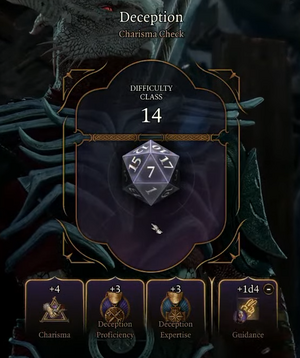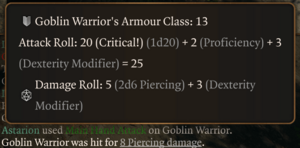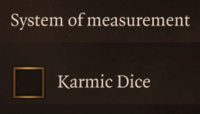Dice rolls: Difference between revisions
(reworded summary, minor edits) |
Tags: Reverted Visual edit |
||
| Line 82: | Line 82: | ||
Most ability checks have an associated [[Skills|skill]]. These rolls are often referred to as "skill checks" by the community, although they are not referred to as such in-game. If a creature is proficient with an ability check's associated skill, they may add their proficiency bonus to the results of the roll, in addition to the relevant ability score modifier. Characters with [[Expertise]] in a skill add their proficiency bonus again, effectively doubling the bonus received. | Most ability checks have an associated [[Skills|skill]]. These rolls are often referred to as "skill checks" by the community, although they are not referred to as such in-game. If a creature is proficient with an ability check's associated skill, they may add their proficiency bonus to the results of the roll, in addition to the relevant ability score modifier. Characters with [[Expertise]] in a skill add their proficiency bonus again, effectively doubling the bonus received. | ||
Some ability checks are based only on the base Ability Score. A common example is exerting willpower to use the Tadpole's influence on other characters during dialogue. Checks like this have no applicable proficiency, and never add a proficiency bonus. | Some ability checks are based only on the base Ability Score. A common example is exerting willpower to use the Tadpole's influence on other characters during dialogue. Checks like this have no applicable proficiency, and never add a proficiency bonus. HELPPPPPPPPpppp HEPLLLLLLLLLL MEEEEEEEEEee | ||
== Damage rolls == | == Damage rolls == | ||
Revision as of 19:22, 9 November 2023
Dice rolls are an important mechanic in Baldur's Gate 3 which determine the outcome of many different situations. For example, determining whether a character will succeed or not at using a particular skill, or if an attack will land and how much damage it will do.
Dice are notated with a d followed by the number of sides on that specific die: ![]() d4,
d4, ![]() d6,
d6, ![]() d8,
d8, ![]() d10,
d10, ![]() d12 and
d12 and ![]() d20.
d20.
Mechanics
Dice rolls are abbreviated by specifying the amount of dice rolled, followed by the type of dice, and finally, any applicable modifiers.
When a a single twenty sided die (d20) is rolled with no modifiers, it is abbreviated as 1d20.
When two six-sided dice (d6) are rolled with a modifier of +2, the roll abbreviated as 2d6+2.
The final result of a dice roll is determined by adding together the results of all the dice rolled, plus any applicable modifiers:
- Most rolls have an associated ability, and add a creature's respective ability score modifier to the result of the roll.
- Some rolls allow a creature to add its proficiency bonus to the results of the roll.
- Some equipment, spells, conditions, potions and class features can add a modifier to specific types of rolls.
- Certain environmental effects or circumstances add a modifier to specific types of rolls.
Modifiers may be negative, in which case they may be referred to as penalties.
The range of results is usually given in parentheses. For example, a single dart from a spell does 1d4+1 (2-5) Force damage, meaning it rolls 1d4 and adds 1 to the result, giving a possible total of between 2 and 5 points of damage.
Advantage and disadvantage
A creature may have ![]() Advantage or
Advantage or ![]() Disadvantage on a d20 roll. A creature with either rolls twice (depicted in the game as two dice rolled simultaneously) and uses the higher result if they have advantage, or the lower result for disadvantage.
Disadvantage on a d20 roll. A creature with either rolls twice (depicted in the game as two dice rolled simultaneously) and uses the higher result if they have advantage, or the lower result for disadvantage.
Advantage and disadvantage do not stack. If multiple instances of advantage or disadvantage apply to a roll, a creature still only rolls twice.
A creature with both advantage and disadvantage on a roll only rolls a single die, even if it has multiple instances of either.
Rolls using d20
When a creature rolls dice to determine success, they roll a twenty-sided die (![]() d20) and add the associated ability score modifier to the result of the roll. If applicable, they also add their proficiency bonus and appropriate modifiers from other sources. If the final result equals or exceeds a threshold value, it is considered a success.
d20) and add the associated ability score modifier to the result of the roll. If applicable, they also add their proficiency bonus and appropriate modifiers from other sources. If the final result equals or exceeds a threshold value, it is considered a success.
Rolling a 1 or 20 on a d20 roll is referred to as a "natural 1" or "natural 20". A natural one is always an automatic failure, while a natural twenty is always an automatic success.
Attack rolls
When a creature attacks another, they usually make an attack roll. Attack rolls are made against the target's Armour Class (AC). If the final result of the attack roll is equal to or exceeds the target's AC, the outcome is a hit. Otherwise, it considered a miss.
Attack rolls are always required for weapons and unarmed strikes, and some spells, such as and , also rely on attack rolls.
Melee attacks generally use the creature's Strength modifier, and ranged attacks use Dexterity, or Strength for thrown weapons. Weapons with the Finesse property use whichever of those two modifiers is highest. Spellcasters use their spellcasting ability modifier for attacks made with spells. Some magical effects, like the spell or a Warlock's , allow spellcasters to use their spellcasting modifier for weapon attack and damage rolls.
A creature's proficiency bonus is added to attack rolls made with weapons they are proficient with. Classes capable of spellcasting add their proficiency bonus to the attack rolls of spells they cast.
When an Attack is determined to be a hit, the creature rolls for damage.
Critical hits
A natural 20 on an attack roll is a critical hit. In addition to being an automatic hit, the creature rolls twice the normal number of dice to determine damage, including additional dice such as those from smites or combat manoeuvres. "Flat" damage bonuses that add a fixed number are not doubled by a critical hit; this includes ability score modifiers, weapon enhancement bonuses and features and abilities like .
Some equipment, feats and class features (notably the Champion Fighter's ) allow a creature to score a critical hit on natural rolls of 19 or 20, or even 18 to 20. The benefits are the same as for a regular critical hit.
Saving throws
Traps, spells, conditions and other sources of harm may allow a creature a chance to avoid or reduce their effect, known as a saving throw or save. This is a d20 roll, with the relevant Ability and Difficulty Class (DC) determined by the source of the effect. If the final result of the roll equals or exceeds the DC, the save is successful.
A creature can be proficient in saving throws on a per-ability basis. Player characters are proficient in two saving throws, based on their class. Proficency adds a creature's proficiency bonus to the saving throw.
Traps, dialogue events and other sources of danger controlled by the game have a DC defined by the game, depending on how serious the danger is. Spells and weapon actions use specific formulas to determine the DC:
- Spell saves have a DC determined by the creature's spellcasting Ability modifier:
- Weapon actions saves have a DC determined by the higher of a creature's Dexterity or Strength, plus an inherent bonus for that specific action:
Effect of success
A successful save can mean completely avoiding negative effects, reducing the damage received (usually by half), or both. For example, successfully saving against a spike trap could mean that a creature takes no damage at all, because it successfully evaded the spikes. On the other hand, if it's caught in the area of effect of a , then a successful save will merely halve the damage. Saving against both halves the damage taken, and prevents a creature from being pushed by the spell.
Some effects don't allow a saving throw, for example the spell .
Death saves
When a player character is , they make a special Death Saving Throw each turn to determine if they slip closer to death. Death saves are not associated with an Ability Score and so don't add any modifiers or the proficiency bonus. They only benefit from bonuses that apply to all saving throws (such as ) or specifically to death saves.
Death saves are a success on a result of 10 or higher, and otherwise a failure. A character dies when three failures are accumulated, or becomes Stable (they no longer make death saves) when three successes are accumulated, whichever happens first.
Ability checks
An ability check is an attempt to succeed at a specific task, and is rolled against the Difficulty Class (DC) of the relevant task. If the final result of the roll equals or exceeds the DC, the attempt is successful.
Ability checks can be triggered by player actions or dialogue choices, or they may be automatic, rolled by the game in the background in response to a trigger in the environment.
Most ability checks have an associated skill. These rolls are often referred to as "skill checks" by the community, although they are not referred to as such in-game. If a creature is proficient with an ability check's associated skill, they may add their proficiency bonus to the results of the roll, in addition to the relevant ability score modifier. Characters with Expertise in a skill add their proficiency bonus again, effectively doubling the bonus received.
Some ability checks are based only on the base Ability Score. A common example is exerting willpower to use the Tadpole's influence on other characters during dialogue. Checks like this have no applicable proficiency, and never add a proficiency bonus. HELPPPPPPPPpppp HEPLLLLLLLLLL MEEEEEEEEEee
Damage rolls
Damage rolls are used in the calculation of damage dealt by weapons, spells and certain special abilities, and use a ![]() d4,
d4, ![]() d6,
d6, ![]() d8,
d8, ![]() d10, or a
d10, or a ![]() d12, adding any relevant modifiers to the results.
d12, adding any relevant modifiers to the results.
Damage rolls always have an associated damage type. For example, a dagger typically deals 1d4![]() Piercing damage.
Piercing damage.
Damage rolled after a successful Attacks with weapons typically add the same ability score modifier as the attack roll of the Attack, but some equipment, spells and class feature bypass this.
Damage rolled after a successful Attacks with spell may or may not add a modifier, depending on the spell, the caster's class, and whether they have the necessary class features. For example, the warlock's invocation allows the warlock to add its Charisma modifier to the damage rolls of its .
Magic items, especially weapons, frequently add bonuses to damage, either as additional dice or flat modifiers. Many class features, feats and other effects can increase damage as well, and some (such as ) can reduce the damage as well.
Healing Rolls may also add modifiers, but these are usually fixed and determined by the source of the healing. For example, a Potion of Healing restores 2d4+2![]() hit points. There are many magic items, class features and other effects which also provide bonuses to healing, for example the Life Domain Cleric's feature.
hit points. There are many magic items, class features and other effects which also provide bonuses to healing, for example the Life Domain Cleric's feature.
Heals work similarly to damage rolls, but instead restore a target's hit points.
Rolls for initiative
When combat starts, all combatants roll for initiative to determine the turn order. This is a d4 roll (a significant departure from the tabletop rules), and adds a creature's Dexterity modifier. Proficiency does not apply, but some items, class features and other special abilities may provide bonuses.
Creatures with the highest rolls act first. Allied player-controlled characters with the same Initiative result effectively act simultaneously; the player can switch between them to coordinate their actions, and the game waits until all such characters have ended their turns to move on to the next creature.
Karmic Dice
When the Karmic Dice option is enabled (it is by default), the game will avoid streaks of very low or very high rolls in a row.
However, Karmic Dice influence all rolls – including those of enemies – and the results will only ever skew toward a positive result for the dice roller. In short, the Karmic Dice setting makes combat encounters quicker and deadlier for both you and your enemies.
Karmic Dice was previously referred to as "Loaded Dice".
Random Results
The results of Wild Magic feature of the Wild Magic and the Rage: Wild Magic feature of the Wild Magic Barbarian are also determined with dice rolls.


